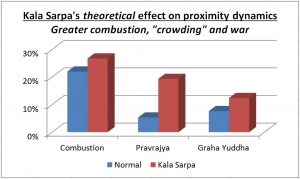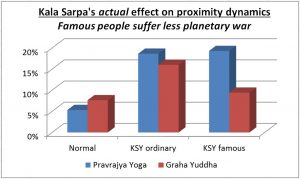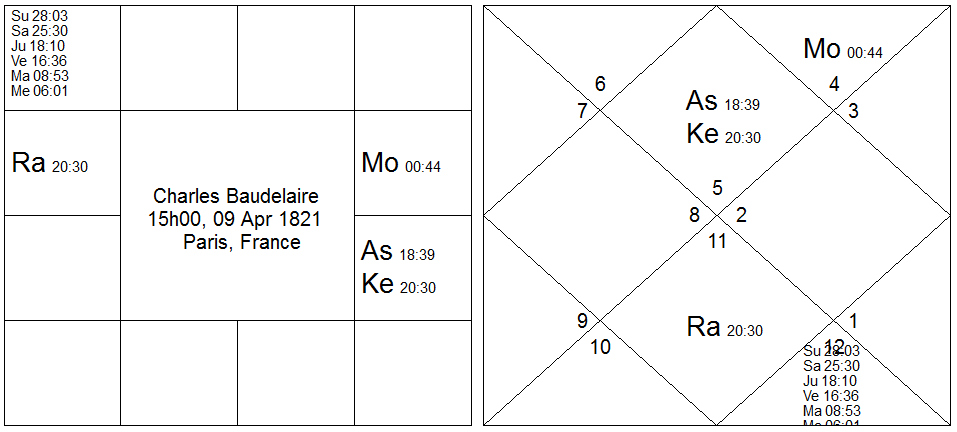 As I discussed in last monthâs article, one of the great uncertainties among devotees of jyotisha is whether Kala Sarpa is a yoga or a dosha. The existential question is: does it promise success or threaten destruction?
As I discussed in last monthâs article, one of the great uncertainties among devotees of jyotisha is whether Kala Sarpa is a yoga or a dosha. The existential question is: does it promise success or threaten destruction?
As I explained in that article, there are multiple consequences when the chart is split in two by the nodal axis, and the planets constrained to roughly half of the zodiac. (For those unfamiliar with Kala Sarpa, see this definition on my website.) To recap that previous article, hereâs what I found after analysing over 600 Kala Sarpa charts:
- Lunar phase. In the average ânormalâ chart, bright moons are just as common (25%) as dark moons. But in Kala Sarpa charts, bright moons are infrequent (7%) while dark moons are far more common (40%). Since the Moon is a significator of the mind, its weakened avastha under Kala Sarpa constitutes something of a flaw, or a dosha.
- Combustion. Among average charts, 22% have a âseriouslyâ combust planet within three degrees of the Sun. But in Kala Sarpa charts, up to 26% of them have a âseriouslyâ combust planet. Combustion is also a detriment to a planetâs avastha, such that whatever the planet represents may be harmed to some degree, thus contributing to dosha.
- Retrogression. Whereas 70% of normal charts have at least one retrograde planet, only 45% of Kala Sarpa charts have a retrograde planet. Since retrogression enhances the brightness or âauraâ of a planet, itâs a positive avastha. But under Kala Sarpa conditions, bright planets are reduced dramatically, producing a sense of loss, or dosha.
Such are the astronomical conditions that diminish the avasthas of the planets, causing dosha â blemish or defect â in certain life experiences.
But the Kala Sarpa can also be a yoga-maker, because when planets are restricted to just half of the zodiac, the odds of two or more of them occupying the same sign increase. And as more planets come into association, the more opportunities there are to form yogas.
The nature of those yogas, however, does depend on what houses such planets in association rule. But since so many yogas are positive, Kala Sarpa facilitates their appearance. Following is a discussion of some of those possibilities.
Pravrajya yoga
Pravrajya Yoga is formed when at least four of the visible planets are contained within one sign. The nodes do not count, but they can join in, once four planets qualify as Pravrajya. These three scenarios should make this definition clear:
- Three planets plus a node in any one sign does not form the yoga, for example, the chart of Lee Harvey Oswald, who has the Sun, Mercury and Venus with Rahu in Libra.
- Four or more planets in one sign does form the yoga, for example, the charts of Charles Baudelaire (see discussion below), Charles Bukowski, Marie Curie, Deepak Chopra, Charles Manson, and Nikola Tesla.
- Four or more planets plus a gratuitous node also forms the yoga, for example, the charts of Garth Brooks and Brad Pitt.
Pravrajya yoga suggests a singular focus in one particular domain of life. Traditionally, itâs been associated with spiritual endeavors, since itâs also called Sannyasin yoga, wherein great concentration is a good and necessary quality. However, not everyone with Pravrajya yoga is destined to be a yogi, and it requires a special combination of planets and house lords in good bhavas to really make the native a sannyasin.
We can calculate (see my book Kala Sarpa, Appendix 3) that the odds for an average chart to have four planets in one sign is just 5.3%. However, once we restrict the planets to roughly half the zodiac, the chances jump to 19.3%. In other words, Kala Sarpa charts are more than three times more likely to have Pravrajya yoga.
Graph 1 below illustrates the consequences of crowding planets into roughly half of the zodiac. The values shown here reflect theoretical (calculated) frequencies for comparing the average chart to those with Kala Sarpa.

As noted earlier, Kala Sarpa increases combustion by a few percentage points compared to the average chart. And as discussed above, Kala Sarpa more than triples the chances of forming Pravrajya yoga.
But as a consequence of having four planets in one sign, the chance of planetary war also increases. Since this is another astronomical phenomenon that affects planetary avasthas, it too merits a closer look.
Graha yuddha
Graha yuddha, or planetary war, occurs when two true planets (Mars, Mercury, Jupiter, Venus, or Saturn) conjoin within one degree of longitude. If theyâre separated by more than one degree, even if only 01 deg 01 min of arc, itâs not planetary war. And the luminaries are never involved in planetary war.
We can calculate the odds for planetary war, both in the average chart and those with Kala Sarpa. First consider the outer planets, which enjoy complete freedom of movement relative to the Sun. Among themselves, and with the inferior planets, Planet A engages in planetary war with Planet B within one degree of approaching exactitude, and one degree of separating, for a possible two degrees out of 360. In other words, thatâs 1/180 or a mere 0.6% of the time.
Between the inner planets Mercury and Venus, the chances of planetary war are higher. From Earthâs perspective, Mercury is always within 28 degrees of the Sun, while Venus is never more than 48 degrees from the Sun. Even if Mercury was as far east of the Sun as it could get, and Venus was as far west as it could get, the two are never more than 76 degrees apart. Therefore, ignoring the complications of retrogression, Mercury and Venus form planetary war within a two-degree arc of their entire 76-degree range, or 2.6% of the time.
Under Kala Sarpa, the chances of the outer planets forming planetary war are roughly doubled. However, between Mercury and Venus, the odds remain essentially unchanged, since theyâre astronomically restricted to a range that is already less than whatâs imposed by Kala Sarpa.
There are 10 different pairs of graha yuddha possible among the five true planets. The theoretical chance of planetary war in the average chart is 7.6%, but under Kala Sarpa, itâs 12.4%. (These percentages are displayed in the âGraha Yuddhaâ columns in the previous graph.)
However, in an analysis of 600 charts, the observed occurrence of planetary war is 13.6%. In other words, Kala Sarpa almost doubles the actual incidence of graha yuddha compared to the average chart.
Technically thereâs always a winner in planetary war, but the result is often similar to a heavyweight fight that goes a full 15 rounds. By the final bell, both opponents are virtually on the ropes. Just as in real war, graha yuddha harms both parties to the conflict. Thus, Kala Sarpa raises the odds of damaging one planet or another, and therefore, some aspect of the life.
However, when we compare the incidence of Pravrajya yoga and graha yuddha across three different populations â the general public, as well as both ordinary people and famous people with Kala Sarpa charts â an interesting phenomenon emerges.
In Graph 2 below, the first pair of columns shows that, for the general population, theoretically 5.3% will have Pravrajya yoga in their charts, while 7.6% will have graha yuddha. However, in actual Kala Sarpa charts, the observed incidence of both Pravrajya yoga and graha yuddha jumps dramatically, as seen in the other two pairs of columns.

Note the difference, however, between ordinary and famous people with Kala Sarpa charts. Although both groups have the same observed incidence of Pravrajya yogas (18.8%), the presence of graha yuddha is radically different. Whereas planetary war occurs 16.0% of the time in Kala Sarpa charts of ordinary people, it appears only 9.5% of the time in charts of famous people.
Although many other factors contribute to fame, we might speculate that, although Kala Sarpa favors the formation of Pravrajya yoga, famous people are more fortunate in the disposition of those particular planets. In a famous personâs chart, the planets in Pravrajya yoga tend to be spread out more evenly, thus avoiding planetary war and the damage it does to affected planets and the departments of life ruled by them.
Aside from Pravrajya yoga itself, the potential consequence of four or more planets in association is that they may in turn form multiple other yogas, depending on the ascendant and the houses ruled by those planets. As an example, consider the following case study, just one of 36 presented in my book as examples of how to interpret this complex pattern.
Charles Baudelaire
Charles Baudelaire was a French poet best known for a single collection of poetry, Les Fleurs du Mal (Flowers of Evil) which was widely admired by fellow artists while simultaneously condemned by authorities for offending public morals. He studied law but chose a literary career, much to his familyâs despair. He received an inheritance but squandered most of it within 18 months. He was in chronic debt throughout his life, lived in cheap hotels, and once moved six times in one month just to avoid his creditors.
He was tormented and complicated â a Catholic Satanist, a debauched mystic, a cynical sensualist who searched for purity among prostitutes, yet reveled in sexual sadism. He contracted syphilis at an early age and developed an addiction to opium to ease the pain of his affliction. Between that and heavy drinking, he was in poor health for much of his life. By age 41, signs of insanity were evident, and by age 46 he scarcely knew his own name. He died at age 47 in his motherâs arms.

Baudelaire has six planets in his Pisces 8th house. Overall, this remarkable cluster, aside from forming Pravrajya yoga itself, contains 11 Raja yogas and six Dhana yogas! Surprisingly, since all five true planets occupy the same sign, no pair of them is close enough to engage in planetary war.
Lagnesh Sun forms Raja yogas with every other kendra/trikona lord: twice with Mars, and once each with Jupiter, Saturn, and Venus. Mars is yogakaraka for Leo lagna and forms multiple Raja yogas with other kendra/trikona lords: twice with lagnesh Sun, and once each with Jupiter, Saturn and Venus. As a trinal lord, Jupiter forms Raja yogas with every kendra lord: Sun, Mars, Saturn and Venus.
As money lord of the 2nd and 11th houses, Mercury forms two Dhana yogas with each of the trinal lords Sun, Mars and Jupiter, although all six yogas are weak due to Mercuryâs debilitation.
Saturn is totally combust in the 8th, the only planet weakened by proximity within this remarkable cluster of planets. Although kendra lord Saturn forms Raja yoga with trinal lords Sun, Jupiter and Mars, these are the least desirable of Raja yogas since Saturn is also a maraka lord.
Kala Sarpa: a mixed blessing
In summary, the astronomical parameters dictated by of Kala Sarpa have astrological consequences. As we saw in my previous article, the crowding of planets into half the zodiac restricts the brightness of the Moon and that of the true planets by curtailing, respectively, its lunation cycle and their retrogression phases. Similarly, Kala Sarpa forces the planets into clusters, risking combustion and planetary war.
Meanwhile, however, this same crowding phenomenon greatly increases the chances of planets forming Pravrajya and multiple other yogas, eg, Raja, Dhana, etc, that lend power to a chart and, with Godâs grace, success or fame to the native.
Thus, weâre reminded of the infamous (and ambiguous) Chinese curse: May you live in interesting times. At best, Kala Sarpa might be viewed as a mixed blessing, albeit one that requires careful judgment as to its final outcome.
~~~
Alan Annand studied with Hart de Fouw, and is a graduate of the American College of Vedic Astrology and a former tutor for the British Faculty of Astrological Studies.
 He is the author of several non-fiction books. Kala Sarpa is a first-of-its-kind reference book on a unique pattern in jyotisha that is not discussed in shastra yet is part of Indiaâs rich oral tradition. Stellar Astrology, Volumes 1 & 2, offer a wealth of time-tested techniques in the form of biographical profiles, analyses of world events, and technical essays. Parivartana Yoga is a reference text for one of the most common yet powerful planetary combinations in jyotisha. Mutual Reception is an expanded companion volume for western practitioners, covering the same subject of planetary exchange through the lens of traditional astrology.
He is the author of several non-fiction books. Kala Sarpa is a first-of-its-kind reference book on a unique pattern in jyotisha that is not discussed in shastra yet is part of Indiaâs rich oral tradition. Stellar Astrology, Volumes 1 & 2, offer a wealth of time-tested techniques in the form of biographical profiles, analyses of world events, and technical essays. Parivartana Yoga is a reference text for one of the most common yet powerful planetary combinations in jyotisha. Mutual Reception is an expanded companion volume for western practitioners, covering the same subject of planetary exchange through the lens of traditional astrology.
His New Age Noir crime novels (Scorpio Rising, Felonious Monk, Soma County) feature astrologer and palmist Axel Crowe, whom one reviewer has dubbed âSherlock Holmes with a horoscope.â
Websites: www.navamsa.com, www.sextile.com
You can find his books on Amazon, Apple, Barnes&Noble, Kobo and Smashwords.
What happens when graha Mallika you which makes u an emperor like Jawaharlal Nehru happens and I believe he also has KSY.Even in KSY,when grahas are in 2/12 does that not also deliver bad results?
A Graha-Malika is just one of the Nabhasa Sankhya yogas, although of an uninterrupted sort. The Nabhasa Sankhya yogas are formed when the visible planets, excluding the nodes, fall in seven, six, five, four, three, two signs, or even one. Graha-Malika is when the planets occupy six contiguous signs. The Nabhasa Sankyha yoga formed in Nehru’s case is called a Daama Yoga, which says that the person is liberal, educated, helpful to others, endowed with many sons, becomes wealthy through legitimate means, attains fame and happiness, and is interested in doing religious rites.
As for Nehru’s KSY, it is generally beneficial because swarashi Jupiter is on the nodal axis, even though it receives the aspect of Mars. There’s no problem with planets being in the 2nd and 12th houses. (Eg, if they were both benefics, this would create Subhakartari Yoga.) In Nehru’s case, it’s an unafflicted Mars in the 2nd, and swarashi Moon in the 12th.
Thanks Alanji….is it true that ketu multiplies the power by a factor of 4 when with a swarashi planet ? Have heard this only about ketu not rahu btw….so Nehrus Jupiter yuti ketu in 6th house,gave the Empire as the enemy but as the 9th Lord also gave PMship for 17 long years till his death…..have u found this to be valid rule?
I’ve never heard of this “multiplier” effect before, certainly not expressed in numerical terms. By coincidence, I happened to employ a numerical factor in a few recent posts (see my Nodal “Weather” Reports for Jan/Feb/Mar on this site) but that was just to establish a hierarchy of planetary effect (conjunction, aspect, sign lord, star lord) upon the transiting nodes, simply for the convenience of graphical display. I’ve never heard of the “rule” you’re citing, but am now curious, Do you recall the source?
Alanji, I have seen this mentioned in a lot of forums… It seems that this is from a book Phalit Sarovar by Raghunandan Prasad Gaur and quotes “Ketu represents Flag (pataka). Whenever Ketu is conjunct any planet who’s in its own sign/MT/exaltation Ketu increases the power of that planet by 4 times (i.e. takes its flag very high). It even take it higher if Ketu is also in exaltation/MT sign. (e.g. JL Nehru).”